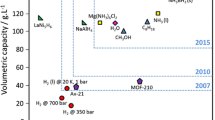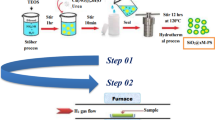Abstract
The influence of the titania support and metal particle size on the performance of nickel-iron catalysts in the Fischer-Tropsch synthesis has been studied by varying the nickel-iron loading and, consequently, varying the nickel-iron particle size. Low-loaded titania-supported nickel-iron catalysts (2 wt%) turned out to be more selective towards higher hydrocarbons than high-loaded nickel-iron catalysts (20 wt%), which produce much more methane. From temperature-programmed hydrogenation experiments, magnetic measurements and Mössbauer spectroscopy it followed that different types of carbon are present on the catalysts depending on the metal loading. These types of carbon could be related to the selectivity in Fischer-Tropsch synthesis and to the deactivation of the catalysts with time on stream. These differences in catalytic behaviour are most likely due to the presence of TiO x species on the surface of the active phase, which species decrease the CO and H2 adsorption properties of the catalyst, but increase the dissociation of CO.
Similar content being viewed by others
References
J. van de Loosdrecht, A. J. van Dillen, A.M. van der Kraan and J. W. Geus, J. Catal., submitted.
J. van de Loosdrecht, PhD Thesis, Utrecht University, Utrecht, The Netherlands (1995).
E. Iglesia, S.C. Reyes, R.J. Madon and S.L. Soled, Adv. Catal. 39 (1993) 221.
F. van Looij, PhD Thesis, Utrecht University, Utrecht, The Netherlands (1994).
S.J. Tauster, S.C. Fung and R.L. Garten, J. Am. Chem. Soc. 100 (1978) 170.
S.J. Tauster, Acc. Chem. Res. 20 (1987) 389.
G.B. Raupp and J.A. Dumesic, J. Phys. Chem. 88 (1984) 660.
J. van de Loosdrecht, A.J. van Dillen, A.A. van der Horst, A. M. van der Kraan and J. W. Geus, Topics in Catal. 2 (1995) 29.
P.W. Selwood,Chemisorption and Magnetization (Academic Press, New York, 1975).
H.P.C.E. Kuipers, Solid State Ionics 16 (1985) 15.
O.L.J. Gijzeman, XPS analysis of catalyst surfaces, unpublished.
H.P. Klug and L.E. Alexander,X-Ray Diffraction Procedures (Wiley, New York, 1974).
P. Scherrer, Gött. Nachr. 2 (1918) 98.
S.J. Tauster and S.C. Fung, J. Catal. 55 (1978) 29.
C.E. Johnson, M.S. Ridout and T.E. Cranshaw, Proc. Phys. Soc. 81 (1963) 1079.
J.G. McCarty and H. Wise, J. Catal. 57 (1979) 406.
Author information
Authors and Affiliations
Rights and permissions
About this article
Cite this article
van de Loosdrecht, J., van der Kraan, A.M., van Dillen, A.J. et al. Metal-support interaction: titania-supported nickel-iron catalysts. Catal Lett 41, 27–34 (1996). https://doi.org/10.1007/BF00811708
Received:
Accepted:
Issue Date:
DOI: https://doi.org/10.1007/BF00811708




